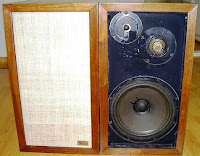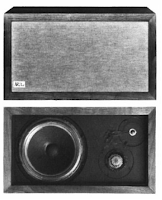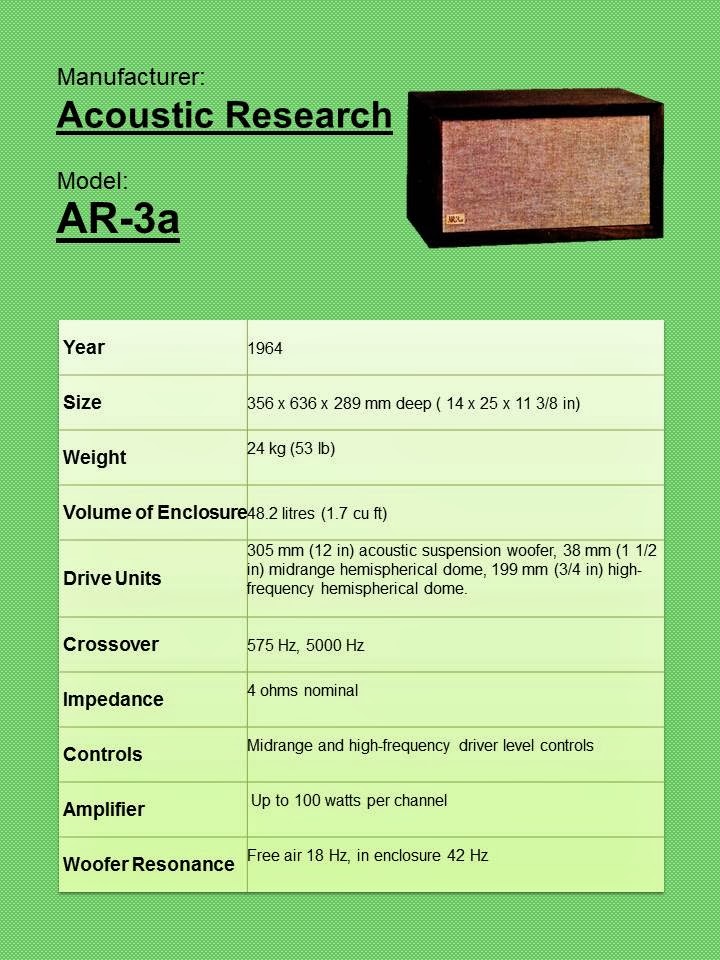The AR-3a was Acoustic Research´s High-end speaker and customers had to pay around 500$ to buy a pair, a fortune at the time. In the manual (see below), the company describes the AR-3a as “the best home speaker system we know how to make” and it is even today an impressing vintage speaker. The AR-3a had to comply with highest expectations, as the original AR-3 (developed in the late 50ies) was the highest quality speaker available for nearly a decade and had been used in a variety of professional settings. You can find information about the original AR-3 speaker from 1958 in our review. When the AR-3a was introduced in the mid 60ies it took over the role of the AR-3. Acoustic Research placed a new set of smaller dome midrange and tweeter into the cabinets. By 1966 Acoustic Research held more than a third of the US market shares in the speaker market, the highest share ever measured in the industry.
Refoaming the AR-3a speaker
An old AR-3a is definitely worth it to be refoamed. Many of the available speakers have broken or worn out foam surrounds which can easily be replaced. A refoaming kit can usually be bought for around $30 and replacing old foams will just take around 1 to 2 hours. There are surrounds available that fit to a variety of speakers and some that are produced for very specific speakers, such as red foam surrounds for CW speakers. The AR-3a does not need a specific kit and it is fairly easy to install a kit. It does not require any particular skill, just a calm hand and a little patience. We tried out a variety of available foams and recommend to use this 12 inch refoam kit by parts express.
AR-3a Speaker Review and Specs
 |
| Acoustic Research AR-3a |
The AR-3a is a three-way speaker and measures approximately 25” x 14” x 11½ ” inches and weigh about 46lbs each. It´s cabinet is made of real walnut veneer, grills are mostly cream colored. Each speaker has a 12 inch woofer, a dome midrange and a ¾ inch dome tweeter. High and mid-frequencies can be additionally adjusted at the back of each speaker. I can recommend to place the AR-3a´s on small stands, in this case solely to keep them a little cleaner and safer.
The sound of the AR-3a´s is very warm, but clear. Considering the fact that the speakers are nearly 50 years old, their bass is strong too. However, not rock or heavy bass music, but music with classical instruments or in general classical music lets these speakers shine. A big pro for these speakers is the huge variety of replacement parts available. You can constantly find replacement screens, refoam-kits (but you need to know how to refoam!) or little “AR-3a” logos on ebay. If you consider buying one of these vintage favorites you have to be aware that they can cost quite a bit of money and sometimes it can be beneficial, if you know how to restore vintage speakers, as many have worn down parts. A big plus is that there are many restoration guides, some of which are very detailed.
You found this speaker? Clean it!
We frequently receive images of old, dusty speakers that some lucky owner found in his or her garage after decades of storage. Others purchased an old set of speakers for little money at a garage sale. Our advice: Don´t let them deteriorate, but also don´t scratch them with the wrong tools.
Instead: Clean them carefully. Get a set of soft brushes and other cleaning utensils. If the wooden speaker cabinets look dull or out of color (e.g. due to sunlight), give the wood some new life:
1. wipe off the dust .
3. Use an oil finish, ideally “natural” to maintain the original wood color, such as Tried and True danish Oil.
AR-3a Quote from 1970
A quote from the original Acoustic Research owner´s manual: The Ar-3a is the best home speaker system we know how to make. It has been designed to reproduce music as accurately as present day knowledge of acoustics and electronics permits. In addition to incorporating the 305mm (12in) bass driver with which AR introduced its acoustic suspension systems to home listeners, the AR-3a was the first speaker system to use two miniature hemispherical speakers developed by AR to give better midrange and high-frequency response. The new miniature speakers offer an unprecedented degree of accuracy in their respective ranges.
The design of such small speakers – one is only 19mm (3/4 in) in diameter – although technically difficult, allows the laws of physics to operate to the listener´s advantage. While larger speakers must beam high frequencies straight forward, AR´s hemispheres instead spread these frequencies through a wide angle, considerably improving the realism of music reproduction for listeners in all parts of the room.” (Quote out of my old AR-Manual, 1970ies)
 Acoustic Research AR-3a Specifications:
Acoustic Research AR-3a Specifications:
Drive Units: 305 mm (12 in) acoustic suspension woofer, 38 mm (1 1/2 in) midrange hemispherical dome, 199 mm (3/4 in) high-frequency hemispherical dome.
Crossover: 575 Hz, 5000 Hz
Impedance: 4 ohms nominal
Controls: Midrange and high-frequency driver level controls
Amplifier: Up to 100 watts per channel
Size: 356 x 636 x 289 mm deep ( 14 x 25 x 11 3/8 in)
Weight: 24 kg (53 lb)
Woofer resonance: Free air 18 Hz, in enclosure 42 Hz
Volume of enclosure: 48.2 litres (1.7 cu ft)
AR-3a Price: $800+in good condition up to $1400.
 |
| Acoustic ResearchAR-3a Specs Sheet |

could you folks please find a pair of Marantz HD 770/880 from the mid 80s .these were designed by dr may from JBL (Marantz enticed him buy building a state of the art lab for him) he designed 3 different series of models over about 4 years ,I believe this was the last speakers he saw go from the drawing board to the retail stores, since these can be considered air suspension and turned port with the VARI-Q system I wanted to see what you folks think of these .just like many others companies ,Marantz let the lab fall apart after DR Mays passing(this is when Philips bought them .I still own them and love the sound .thank you pat b
How much are they worth as I have a set of Rogers compact ar3,speakers?
One information if is possible, my AR 3a pair are with 65035 and 65131 as serial number, so not matched like consequential serial number, is strange you know because?
Marco
These speakers were exceptional in their day, but even today (nearly 50 years on), you are hard pressed to find a speaker that reproduces the spoken human voice better. For example the spoken intro on 'You Took The Words Right Out of my Mouth (Hot Summer Night)' (Meatloaf) still today sounds incredible.
My experience with Acoustic Research's customer service was fantastic. When mine were about 18 years old they worked but with a scratchy tone control. They were well outside guarantee (5 years). I wrote to AR, and they send me some packaging and then arranged to pick them up, repaired them and returned them to me, all without charge!!' Given that a pair weigh 106 lbs (52 kgs), the carriage alone would have been expensive. Now that is fantastic service for you, and shows what pride a manufacturer has in their product.
A good pair are still a joy to listen to;, they have a lovely sound in the right room, but you do need a powerful amplifier to get the best out of them.
I just happened up on a pair of AR 3a's at a thrift store
I couldn't believe my eyes as I grabbed a sales person to
put a SOLD sign on them $50 bucks minus 30% for senior day!!!
I recall the early 60's when the rich only had these babies..
I think I heard them @ a Stereo Shop in Falls Church VA. in 66'.
They do need refoam but are in good condition …Rich K
Wow, that is a steal! Congratulations. I will never, ever sell mine.
This part of the review is baloney: "However, not rock or heavy bass music"
I have FOUR AR3a I just bought for, let's say, a pittance, but at least two need refoaming; the good news is that one pair has the early heavy Alnico magnets. One pair of grilles is missing now but the other was redone in an attractive darker brown light cloth. I plan to rebuild all speakers and resell a pair, because i also got (free) a pair of large Advents (walnut) in excellent condition except for refoam needs also.
I have a pair of 3a, serial numbers 3A 01352, and 3A 01364. They are unmolested. The have never been opened, completely original and the cabinets are in pretty nice shape (given their age): no water stains, no chips, a little dusty and might like some good oil. The cross-over pots could use some TLC, but, all in all, not bad. I am certain (given the S/Ns that these were bought in a pair when they were new. My question is: is there anyway to date these without opening the cabinets?
I have an all original pair of AR3a Improved with original crivers that my father purchased brand new. I was wondering if anyone has seen a pair with the original cabinets in Zebrawood veneer. I have never seen another pair in this finish.
I have a pair of AR3A speakers that were stored in a barn for years. Unfortunately water damage. Lost the speakers themselves. And the bottom of one of the cabinets was damaged as well…But I still think the cabinets themselves could be restored and wonder if it may be worth it to list them on ebay for someone with just the speakers…could be a worthwhile project?
they were never sold with consequential serial numbers. I got a pair at sound salesman discount and picked them up from the factory in the sities.
I have a pair of AR-3a speakers in the rare birch finish. They sound great and are cosmetically excellent. I'm just learning about them, as I don't really have a place for them, and I'm planning to sell. In the 80's I was super into high end equipment, but I don't know much about AR speakers. What do I have here?
I bought a tarted up beaten up late period AR3a a couple of years ago. It sounded horrible at first, with aftmkt tweeters, one chaffing squawker, and a bad wood veneering job. Alas.
But I just rebuilt its cross over with new electrolytic bipolars, and.used new wire wound potentiometres of 20 ohm/25 watts.
They sound great aftwds, except with the ringing squawkerz due to its vc chaffing the pole piece.
But I must agree it sounds terrific with voices, be it radio or light Jazz, or simply pop music. Added a subwoofer pair corss overed at 160hz, it is now suitable for rock, pipe organs, heavy metals (due to the AR3a's midrange clarity) and practically any music.
I like them best when I use them in AV applications.
Just had my father's 3a's refurbished. One of the tweeters was bad, my brothers blew several. They should be fused with today's high powered amps. They were not designed for playing loud pop/rock, but they do sound good if cranked up a bit. They are not as detailed as more modern (and expensive) speakers, and do have a slight boxy sound in the upper bass. That said, if you listen to classical, jazz, or folk, these smallish speakers are hard to beat. Designed to fill the room with great off-axis treble response, the imaging is not a precise as more beamy speakers, but to get that image one must sit in the correct spot. The ARs deliver a believable image at more listener locations. They are never harsh and get out of the way of the music. A remarkable achievement for the 1960s, much of the design (acoustic suspension & domes) was copied so that they were not as much ahead of the field by the 70s. Still can do the job of accuracy and fidelity better than many current efforts, but they are pricey for 60-year-old devices. They will allow you to hear actual high fidelity audio, not the pretty or showy sound valued by some.
In about late 1969, a friend of mine had a pair, and at the time, they were THE speakers to buy for home use. After smoking some pot, he played for me Santana’s new album, “Santana”, and after I closed my eyes, without noticing, I gradually envisioned the stage, and all the band members in their respective places, and then essentially hallucinated the entire albums. After it was over I was astonished to open my eyes, and see my friend’s two AR3s. I mean I intently “watched” each musician move and play as I looked around the “stage”.
Another time he connected a small transistor radio to one of the speakers to show me how little power it took to use it, and the music still sounded very clean and natural.
A few months later, I was able to buy a pair of AR3a speakers (used) for myself. I will never forget the realistic sound that always came from them, including a fireworks recording that captured those low pops and booms perfectly. I used a 35 watt Dynaco tube amp, and never lacked for power. I would say that more power would be needed for larger rooms or very loud listening, but I never needed more. Eventually, when I moved, I had to sell them. They remain legendary, but time and technology move on.